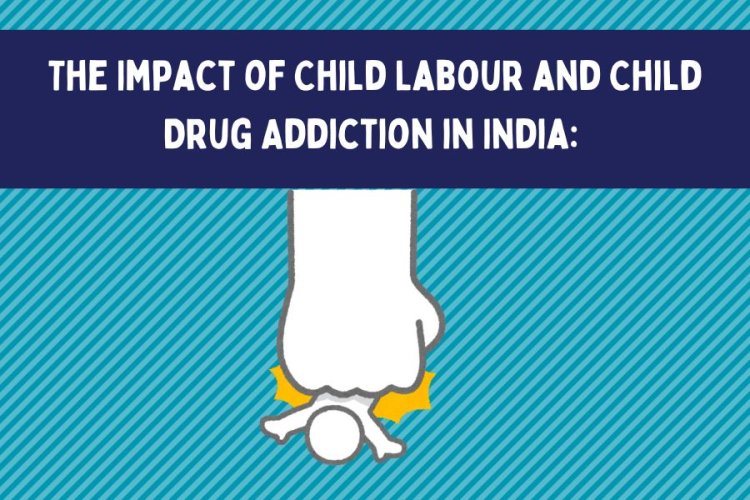The Impact of Child Labour and Child Drug Addiction in India: A Growing Crisis

India, a nation known for its vibrant culture, diverse heritage, and fast-growing economy, faces severe social issues that undermine the progress of its younger generation. Among these challenges, child labour in India and child drug addiction in India are two deeply concerning problems that continue to plague the nation. These issues not only violate the basic rights of children but also hinder their opportunities for a better future.
In this blog, we will explore the dire consequences of child labour and drug addiction on Indian children. We will also discuss the root causes of these issues, the socio-economic impact on the country, and what can be done to address these urgent challenges.
Understanding Child Labour in India
Child labour in India remains a serious problem despite various laws and initiatives aimed at eradicating it. According to the International Labour Organization (ILO), India has one of the highest rates of child labour in the world, with millions of children engaged in hazardous and exploitative work.
What is Child Labour?
Child labour refers to the employment of children under the age of 14 in tasks that deprive them of their childhood, education, and well-being. These children are often subjected to hazardous working conditions, long hours, and inadequate wages. The work they do ranges from working in factories, mines, and farms to engaging in domestic labour and street vending.
The Reasons Behind Child Labour
Several factors contribute to the persistence of child labour in India. Poverty is one of the primary causes, as many families rely on the income generated by their children to survive. The lack of access to quality education and social security also forces children to enter the workforce at an early age. Furthermore, certain sectors, such as agriculture, construction, and textiles, exploit children for cheap labour, perpetuating this vicious cycle.
The Consequences of Child Labour
The consequences of child labour are far-reaching. Children working in hazardous conditions face physical and mental health problems, including injuries, malnutrition, and exposure to harmful substances. Their education is compromised, limiting their ability to break free from the poverty trap and contributing to illiteracy rates in the country. Additionally, child labour perpetuates a cycle of exploitation, as children who work in harsh environments often grow up to face similar conditions as adults.
Addressing the Issue of Child Labour
To tackle child labour, the Indian government has implemented several laws, such as the Child Labour (Prohibition and Regulation) Act, which prohibits the employment of children in hazardous industries. Despite these legal measures, enforcement remains weak, and many children continue to work in unsafe environments.
There is also a need for better education and awareness programs that can empower families and communities to break the cycle of poverty and child labour. Providing free and quality education, improving access to healthcare, and creating more opportunities for adult employment can significantly reduce the reliance on child labour.
Child Drug Addiction in India: A Growing Crisis
In addition to child labour, child drug addiction in India is another issue that has escalated over the past few decades. The consumption of drugs among children and adolescents has become a major public health concern. The rise in addiction not only affects the children but also has a far-reaching impact on society at large.
The Scope of the Problem
Reports from various governmental and non-governmental organizations indicate that drug addiction among children in India is on the rise. In some regions, children as young as 10 years old are being exposed to substances like alcohol, cannabis, heroin, and prescription drugs. The situation has worsened in recent years due to easy access to drugs, peer pressure, and a lack of proper education about the dangers of substance abuse.
The Causes of Child Drug Addiction
A combination of social, economic, and psychological factors contribute to the growing problem of child drug addiction in India. Peer pressure is one of the main drivers, with children often turning to drugs as a way to fit in or cope with stress. Family issues, such as parental neglect, substance abuse within the home, and financial hardships, also play a significant role. Furthermore, the lack of awareness and proper counseling in schools and communities leads children to experiment with drugs without understanding the risks.
The Consequences of Drug Addiction
Drug addiction during childhood and adolescence has severe long-term consequences. It affects the child's physical health, leading to weakened immunity, poor growth, and long-term damage to vital organs. The psychological effects are equally damaging, as addiction can result in depression, anxiety, and behavioral problems. Children who are addicted to drugs often experience a decline in their academic performance and face difficulties in forming healthy relationships.
In the long run, child drug addiction impairs the overall development of individuals and increases the risk of criminal behavior, unemployment, and social exclusion. This vicious cycle harms not only the addicted individuals but also their families and communities.
Solutions to Combat Child Drug Addiction
Addressing child drug addiction in India requires a multi-pronged approach. Education plays a key role in prevention. Schools must implement drug awareness programs that teach children about the harmful effects of drug use and offer them healthy alternatives for stress management. It is also crucial to provide support systems for children facing difficult home environments, such as counseling services and mentorship programs.
The government must invest in rehabilitation programs that cater to children suffering from drug addiction. Additionally, strengthening laws to prevent the sale and distribution of illegal substances is essential to curbing the problem at the grassroots level.
Conclusion
Child labour and child drug addiction in India represent two critical issues that need urgent attention. The future of millions of children is at stake, and it is imperative that we take collective action to combat these challenges. By addressing the root causes, providing better access to education and healthcare, and fostering supportive communities, we can create a safer and healthier environment for our children to grow and thrive.
It is not just a responsibility of the government, but of society as a whole, to protect the rights and well-being of children and ensure that they are given the opportunity to live a fulfilling and prosperous life. Only then can we hope to break the cycle of exploitation and addiction that continues to harm the future generations of India.
What's Your Reaction?




















.jpg)
.jpg)